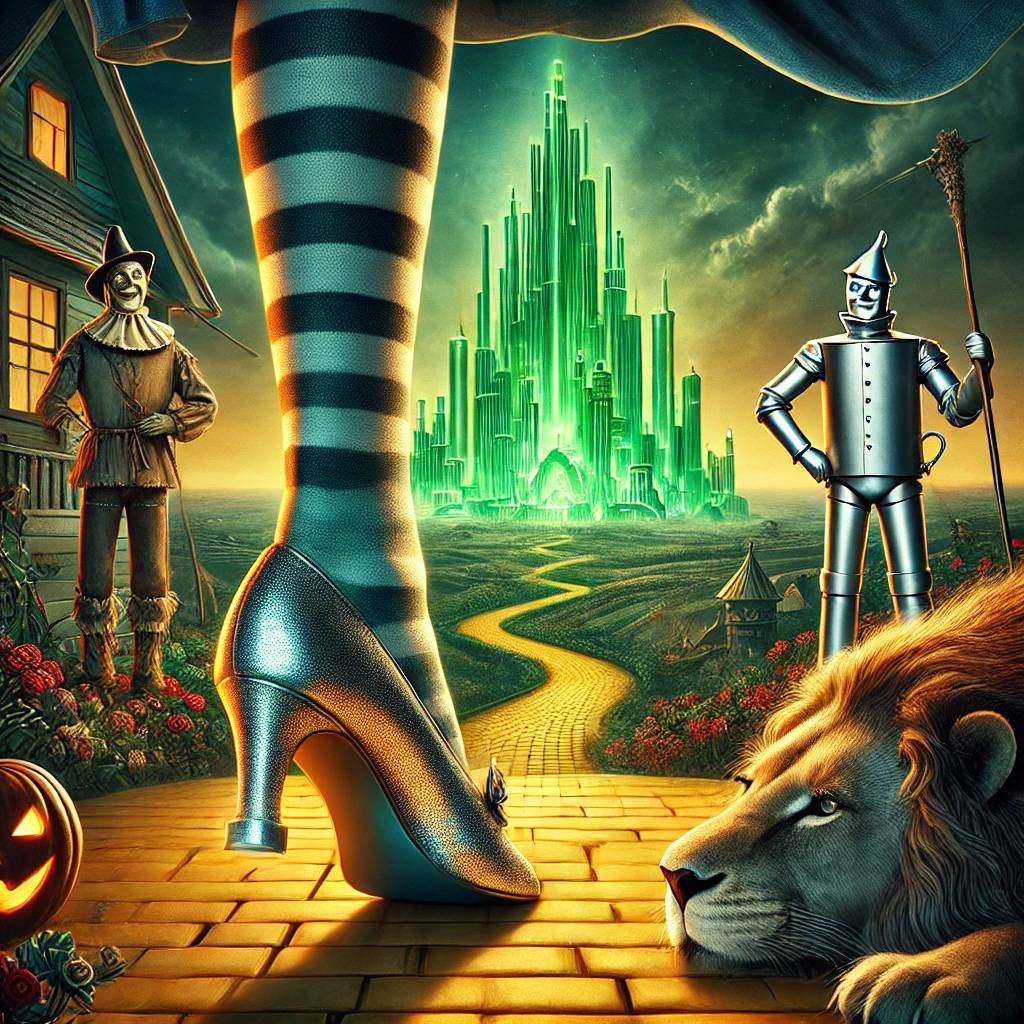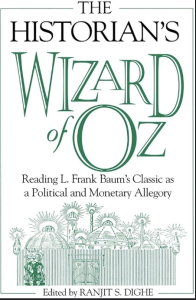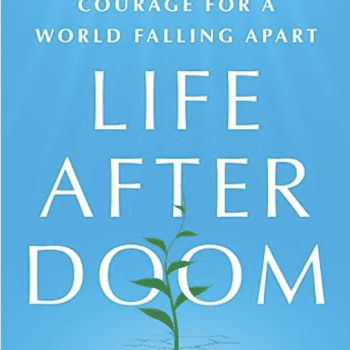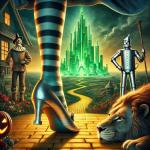
Wicked is a box office smash, earning $722.50 million worldwide so far, and the film has received ten Oscar nominations, including Best Picture, Best Actress in a Leading Role (Cynthia Erivo), Best Actress in a Supporting Role (Ariana Grande), Best Original Score, Best Costume Design. With the Academy Awards scheduled for Sunday, March 2, this feels like an auspicious time to explore the political allegory behind the many iterations of the Oz mythos.
Frank Baum’s classic children’s novel The Wonderful Wizard of Oz was originally published in 1900. Baum wrote thirteen additional Oz books, and the famous film adaptation starring Judy Garland was released in 1939.
 If you are curious to learn more about the allegorical interpretations of that mythology, I recommend The Historian’s Wizard of Oz: Reading L. Frank Baum’s Classic as a Political and Monetary Allegory, was published in 2002 by Ranjit Dighe, a professor of economics at the State University of New York at Oswego. The allegorical interpretation did not break into popular consciousness until 1964, when a high school history teacher named Henry Littlefield published an article titled “The Wizard of Oz: Parable on Populism” which invited readers to look beneath the surface story to see a symbolic allegory about U.S. economics and politics in the 1890s when Baum was writing his book (1).
If you are curious to learn more about the allegorical interpretations of that mythology, I recommend The Historian’s Wizard of Oz: Reading L. Frank Baum’s Classic as a Political and Monetary Allegory, was published in 2002 by Ranjit Dighe, a professor of economics at the State University of New York at Oswego. The allegorical interpretation did not break into popular consciousness until 1964, when a high school history teacher named Henry Littlefield published an article titled “The Wizard of Oz: Parable on Populism” which invited readers to look beneath the surface story to see a symbolic allegory about U.S. economics and politics in the 1890s when Baum was writing his book (1).
As far as scholars can tell, “Baum left behind no concrete evidence that he wrote the book as a political allegory, and…virtually nobody read it as one until more than sixty years later (x). Baum died in 1919 at age 62, more than four decades too early for anyone to ask him directly about potential monetary symbolism in his writing. Of course, even if authors are still alive, sometimes they misrepresent their intentions to critics for a variety of reasons (42). Moreover, sometimes writers unconsciously incorporate symbols and archetypes into their fiction without intent.
Proponents of the allegorical interpretation see The Wizard of Oz in all its versions as being about the plight of western farmers in the late nineteenth century, who had been economically devastated by deflation (falling prices) in the decades following the Civil War. In 1896, William Jennings Bryan was the presidential nominee for both the Democrats and the People’s (Populist) Party. At the 1896 Democratic National Convention, he delivered his famous “Cross of Gold” speech against the gold standard in which he proclaimed, “You shall not crucify mankind upon a cross of gold.” Instead, on behalf of western farmers, he called for “free silver”—“that the government stamp silver bullion into coins, upon demand, to increase the money supply and end the deflation” (2).
As we proceed with the story, I’ll share some more about the allegorical interpretation, but there are many other universal themes. As you likely recall, not long after the family conflict between Aunt Em and Dorothy, a tornado picks up Dorothy’s family’s farmhouse — with Dorothy inside — and carries her inexplicably to the land of Oz. According to the populist allegory, Dorothy of Kansas represents the best traits of farmers from the American West (“honest, kind-hearted, plucky”). In this interpretation, it is no coincidence that Dorothy’s farmhouse lands precisely on the Wicked Witch of the East, who is seen as representing the corrupt “Eastern financial and industrial interests,” especially Wall Street (49).
Although Dorothy famously wore “ruby slippers” in the film, in the novel, Dorothy wore silver slippers. And what did William Jennings Bryan’s “Cross of Gold” speech call for? “Free silver!” From the populist perspective, financial elites in the East were the ones refusing to incorporate silver into the monetary standard. So here we have a Kansas farm girl, killing the Wicked Witch of the East(ern financial elites), and taking her silver slippers down the yellow (gold!) brick road to the capital city (Oz / Washington, D.C.) where they could petition for permanent change (53). And the name Oz, of course, has been seen as explicitly symbolic of the abbreviation for ounce (oz.), “the unit in which gold and silver were measured” (57). Seriously, this allegorical interpretation goes deep. I am not even going into all the layers and details.
As Dorothy’s silver-shoed journey continues down the golden, yellow brick road, she begins to acquire traveling companions. First, she meets the Scarecrow, who has been told that he has “no brains” in his straw head (56). Allegorically, he is a literal “straw man,” a stereotype of a supposed dumb rural farmer (56). We come to see, however, that the Scarecrow is quite shrewd and capable (56).
Next, Dorothy meets the Tin Woodsman, symbolic of workers in the lumber industry, who have increasingly been treated less like humans than robots. The Tin Man’s rust symbolizes prolonged unemployment (60-63),
As Dorothy goes further down the yellow brick road, she soon encounters her third and final companion for the journey—a lion. Since lion rhymes with Bryan, the lion has been seen as symbolic of William Jennings Bryan.
What do you think? Do you prefer this surface-level story? Or the metaphorical depth of allegory? Or both?! Some food for thought, as you wait for “Wicked: Part 2” (officially titled “Wicked: For Good”) to be released on November 21, 2025.












